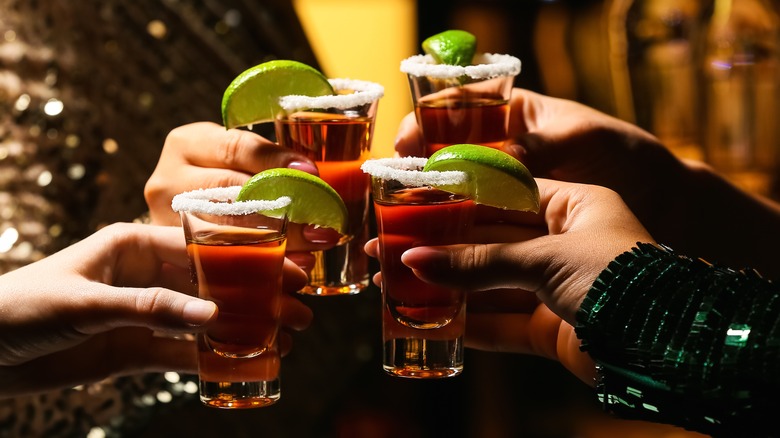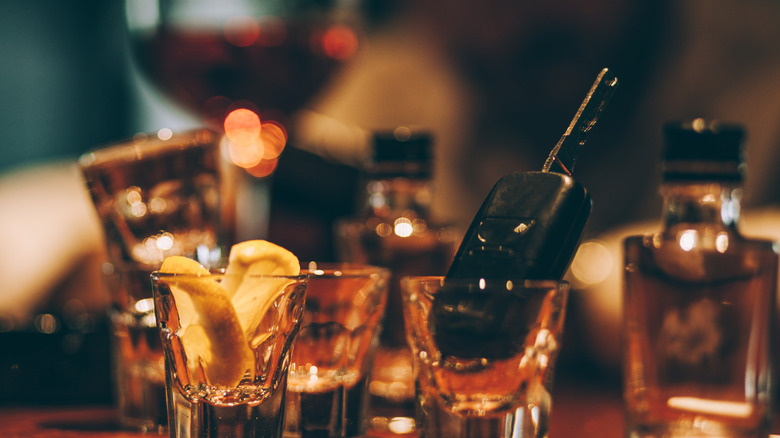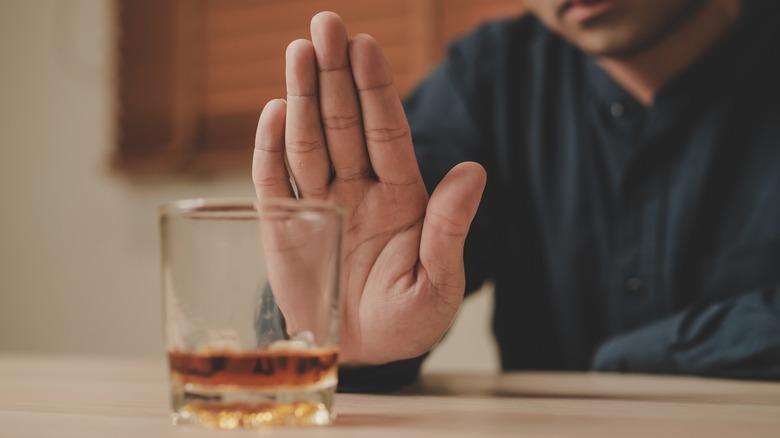Know The Early Signs Of Alcohol Use Disorder
Are you worried that you or a loved one might have a problem with alcohol? It's more common than you might think. According to a 2021 survey by the National Institutes of Health (NIH), almost 30 million Americans ages 12 and older had an alcohol use disorder in the past year.
But what does alcohol use disorder even mean? The Diagnostic and Statistical Manual of Mental Disorders (DSM-5) describes it as an abnormal pattern of alcohol use that causes notable negative impacts on one's life (via the NIH). There are 11 criteria that define the condition, including but not limited to: drinking alcohol in greater amounts and spending a lot of time drinking alcohol or recovering from its effects; having problems at work, school, or home resulting from alcohol use; an increased tolerance to alcohol; and repeated unsuccessful attempts to limit alcohol consumption. To be diagnosed with an alcohol use disorder, an individual must fulfill two or more of the criteria in a 12-month period.
That sounds clear cut on paper, but it's not always so easy to tell whether there is a real problem brewing, especially in the early stages. Here are some signs to look for that you or someone you know might be developing an alcohol use disorder.
If you or anyone you know needs help with addiction issues, help is available. Visit the Substance Abuse and Mental Health Services Administration website or contact SAMHSA's National Helpline at 1-800-662-HELP (4357).
Drinking a lot of alcohol
A beer, glass of wine, or a cocktail at a social occasion or with dinner a few times week isn't anything to be concerned about. For those who choose to drink alcohol, this is considered moderate. In fact, two drinks a day for men and one drink per day for women is still considered moderate drinking (via the NIH). One drink is defined as 14 ounces of light beer, 12 ounces of regular beer, 9 ounces of a microbrew, 5 ounces of white wine, 4 ounces of red wine, and 1.5 ounces of spirits, whether straight or in a cocktail (via the California Department of Alcoholic Beverage Control).
Having an extra glass of wine or beer above the one or two drink per day limit every now and again also isn't necessarily a sign of a disorder, but drinking more than the limit regularly is. If you've noticed your or your loved one's daily alcohol intake creeping upwards, that's a clear sign that there's a problem. The NIH classifies heavy drinking for men as five or more drinks in one day and more than 15 drinks per week. For women, heavy drinking is considered four or more drinks daily or eight or more drinks weekly.
Keep in mind that people often think a glass of beer or wine or a cocktail is one drink; however it may be more than that depending on the size of the pour — in some cases, considerably more.
More time spent on alcohol-related activities
Did your BFF used to enjoy playing sports or watching movies, but now spends a lot more time going out to bars or drinking at home? That's a sign that they're likely consuming a lot more alcohol than they used to, but they're also consciously or unconsciously devoting more time to alcohol-related activities (via Kingsway). People may make excuses that they have new friends or new interests, or that they just need to destress at the club or at home on the couch with a beer. If they're having problems at work or in their personal life, they may use that as a reason for increasing their alcohol intake.
A person in the early stages of an alcohol use disorder may even be convinced that's what they're doing, without realizing that their alcohol consumption is rising and that they're neglecting either activities they used to enjoy or responsibilities. You'll likely see a change in their social habits, not only in where they hang out but who they hang out with. They may choose to hang out more with drinkers now than they did before, and they may avoid hanging out with non-drinkers.
Binge drinking
Even if a person drinks moderately or doesn't drink at all most days of the week, they may still have an alcohol use disorder if they take in a large amount of alcohol at one time on a regular basis. The Centers for Disease Control and Prevention (CDC) calls binge drinking a "public health problem" and the "most common and costly pattern of excessive alcohol use in the United States." It defines binge drinking as men having five or more drinks or women having four or more drinks in one occasion, such as a night out — or a night in.
Binge drinking is surprisingly common, with one in six adults reporting binge drinking, and a quarter of those doing it on a weekly basis. The habit is more common in younger people between the ages of 18 and 34, and men are more likely to engage in it than women. Interestingly, it's also more common among people with higher incomes of $75,000 or more, those who are non-Hispanic or white, and people who live in the Midwest. Just something to keep in mind if you or your loved one fit into one of those categories.
Remember, having the occasional night out where you go a little overboard doesn't necessarily mean you have alcohol use disorder; but if it happens frequently and you have one or more of the other DSM-5 criteria, that's something to consider.
Increased tolerance to alcohol
If you used to get tipsy on half a glass of wine and now it takes half a bottle or more for you to get the same effect, it's because your body has built up a tolerance to alcohol. Chronic drinkers develop a tolerance to alcohol because their brain and body adapts to the changes it causes, both physically and mentally (via the NIH). For example, the liver adapts by processing alcohol in a more efficient manner. According to the NIH, this is called "functional tolerance." If you or your family member used to feel or display more symptoms of being intoxicated, but now seem more "normal" when drinking a similar amount of alcohol, this is a sign of alcohol use disorder.
The danger of developing tolerance is that it can easily lead an individual to consume increasing amounts of alcohol. This can happen either because they don't realize how much they've had to drink because they don't feel "drunk," or because they need to consume more alcohol to get the favorable effects that a smaller amount used to provide. A person may also develop a tolerance to certain unfavorable effects of drinking — such as hangovers — while maintaining the pleasant effects (via DreamLife Recovery).
Behavior changes under the influence
Conversely, although a person may develop a tolerance to some of alcohol's effects — such as slurred speech — that doesn't mean that their behavior under the influence doesn't change. Alcohol has complex effects on the brain and can impair cognitive function in various ways — impaired judgement among them. When drinking, a person is more likely to lose control, engage in more risky behavior, or become violent or aggressive (via American Addiction Centers). They may also become friendlier or louder than usual, or use more profane language than they normally would.
This can happen to anyone who drinks too much, whether once or regularly. When it starts to happen frequently, it's a clear sign that the person is becoming intoxicated on a more regular basis. You may not know they're under the influence because they've built up a tolerance to some of the classic symptoms of intoxication, such as slow movements, swaying, or stumbling (via California Department of Alcoholic Beverage Control). But if their behavior seems different, they could very well be intoxicated.
Having withdrawal symptoms
With increasing amounts and frequency of alcohol consumption, the body develops a dependence on it. When the person stops drinking, they can develop a host of unpleasant symptoms, some of which can be very noticeable to others who are close to them. These include headache, tremors, changes in mood, gastrointestinal effects, fatigue, insomnia, anxiety, sweating, and high blood pressure (via the American Addiction Centers and the NIH). Of course, many health conditions and environmental factors can bring on these symptoms, but if a person is abusing alcohol regularly, they may exhibit these symptoms frequently.
The effects of alcohol withdrawal can develop as soon as six hours after the last drink. These symptoms are typically mild. Heavy drinkers may start to experience more marked effects — including confusion and hallucinations — about 24 hours after their last drink. According to the NIH, approximately 50% of people with alcohol use disorder will exhibit withdrawal symptoms.
Continuing to drink regardless of negative effects
Drinking too much affects every area of your life: your physical and mental health, your job, your relationships, and more. There are no benefits to excessive drinking, only drawbacks. Yet, people who have or are developing an addiction to alcohol will continue to drink even when alcohol use is having marked affects of these aspects of health, success, and happiness.
Hangovers are a deterrent for people who are in control of their drinking. No one likes the way a hangover feels, particularly the fatigue, headaches, nausea, and mood changes it can cause. But people with an alcohol disorder aren't put off. They will continue to drink despite these consequences.
Alcohol use disorder also causes people to miss work. According to Washington University School of Medicine in St. Louis, it's associated with 232 million days of missed work each year. It's estimated that 9% of full-time employees in the U.S. have an alcohol use disorder and miss 18 to 32 days of work yearly, depending on the severity of their disorder.
Relationship problems are another common result of alcohol use disorder. Issues with intimacy, trust, and communication are common, as are verbal and physical abuse (via Discovery Mood & Anxiety Program). Still, a person with an alcohol use disorder may see the havoc it's wreaking on their relationships, but continue to consume.
Depression and anxiety symptoms
Feeling down or anxious are common symptoms of a hangover. Even people who don't have an alcohol use disorder may have experienced these feelings after a night of drinking too much. Alcohol is a depressant and it can affect your brain chemistry, altering the neurotransmitters that control your mood. Alcohol temporarily increases levels of serotonin, neurotransmitters linked with pleasure and happiness (via GoodTherapy). But the after effects can cause a drop in serotonin, actually causing or worsening depression and anxiety.
For people with alcohol use disorder, this creates a vicious cycle, because they may drink more frequently to assuage these uncomfortable feelings. People with pre-existing depression and anxiety may self-medicate with alcohol, which can make their conditions worse. It can also decrease the effectiveness of prescription medication they may be taking (via the Mayo Clinic). A depressed mood, combined with any of the other DSM-5 criteria, is an early warning sign of an alcohol use disorder.
Keep in mind that feeling down isn't the only sign of depression. Symptoms may also include anxiety, restlessness, agitation, anger, frustration, irritability, and outbursts; decreased interest in once-pleasurable activities; sleep problems; changes in appetite; cognitive problems; and feelings of worthlessness and guilt (via the Mayo Clinic). Depression may also lead to increased thoughts of death and suicide or suicide attempts. Per a 2010 research review, alcohol use disorder can increase the risk of suicidal behavior by 10 to 15%.
Other signs and symptoms
There are plentiful signs that you, a friend, or a family member have a problem with alcohol. It may be hard to recognize some of them in others; detecting it in yourself is often easier. You can ask yourself a few questions — or you can ask your loved one, if you're close enough — that will help you determine whether you're dealing with an alcohol use disorder.
Do you feel in control of your drinking? Have there been times where you drank much more than you planned? Do you have blackouts in which you can't remember periods of time or events that occurred while drinking? Do you regularly feel a craving or urge to drink? Do you have feelings of guilt or shame about your drinking? Are other people starting to notice your drinking or criticize you for it? Do you feel that your drinking has put your or someone else's well-being at risk (i.e., driving drunk)? Have you gotten into legal trouble?
If you've answered yes to two or more of these, the Alcohol Rehab Guide suggests this is a good sign that you have a problem and should seek out professional help.
Long-term health risks
Catching and seeking treatment for an alcohol use disorder early can prevent it from causing serious long-term consequences to your health. As a toxin, alcohol damages the liver, reducing its ability to flush it out of your system. Alcohol can also damage liver cells, leading to cirrhosis, a condition characterized by severe liver scarring (via WebMD). Long-term alcohol misuse also increases the risk of alcoholic fatty liver disease, which leads to an increase in fats in the liver cells that can cause the liver to become enlarged (via Johns Hopkins Medicine).
Alcohol misuse can also increase the risk of high blood pressure. This puts extra stress on the heart muscle and can cause heart failure or stroke (via the British Heart Foundation). Long-term excessive alcohol intake can also lead to cardiomyopathy, which affects the ability of the heart to pump blood and can cause irregular heartbeat (via Johns Hopkins Medicine).
Long-term alcohol misuse can damage the brain and reduce the brain's white matter that helps different regions of the brain communicate. This can negatively affect cognitive function and increase the risk of dementia, including Alzheimer's disease (via the Alzheimer's Society). Excessive drinking also contributes to the development of many types of cancer. Per the CDC, research shows that consuming three or more drinks daily raises the risk of stomach, pancreatic, and prostate cancers. The risk increases with the amount of alcohol consumed. Digestive disorders, diabetes, infections, gout, seizures, and anemia are other risks of long-term alcohol misuse.
Treatment for alcohol use disorder
Addiction is complicated, and it's not something that can be easily fixed. In order to get treatment, the individual has to realize their problem and desire to solve it. They may be able to quit on their own, or they may need treatment. However, it's highly recommended to seek out professional help. The rate of relapse is high, with 30% of people drinking again in the first year after quitting (via The Recovery Village). The good news is that the likelihood of relapsing goes down the longer the individual stays sober.
Treatment options include in-patient and out-patient programs. Moderate to severe alcohol use disorder is more likely to require in-patient care and detoxification overseen by a medical professional. During this time, alcohol withdrawal symptoms can be very strong.
Therapy is another important part of treating alcohol use disorder. Cognitive behavioral therapy (CBT) can be helpful in transforming the negative patterns of thought that often cause people to misuse alcohol (via American Addiction Centers). It's also important to receive therapeutic and pharmacological treatment for underlying mental health conditions that may contribute to alcohol misuse. Support groups provide a community of people who are going through the same struggle. It's crucial to have a support network while trying to remain sober.
In some cases, prescription medication may be used to help control drinking by reducing the urge to drink or by causing negative physical reactions to drinking that may help deter people from consuming alcohol (via the Mayo Clinic).












